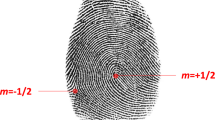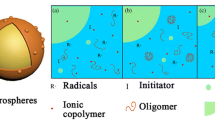Abstract
The formation of microheterogeneous sequential semi-interpenetrating polymer networks based on network polyurethanes with different molecular masses of chain segments between crosslinks and a linear polystyrene has been studied by DSC and small-angle X-ray scattering. It has been shown that variation in the molecular mass of polymer segments between polyurethane network junctions affects the formation of the linear component of semi-interpenetrating polymer networks. As a result, the material structure may change in a wide range from a nearly single-phase system to a two-phase one. SAXS measurements indicate that there is a cymbate dependence between the degree of segregation of components of sequential semi-interpenetrating polymer networks and their microheterogeneous structure on the internetwork space. Two hierarchical heterogeneity levels are found to exist in polymer networks, and the features of each of these levels are analyzed.
Similar content being viewed by others
References
Yu. S. Lipatov and L. M. Sergeeva, Interpenetrating Polymer Networks (Naukova Dumka, Kiev, 1979) [in Russian].
L. H. Sperling, Interpenetrating Polymer Networks and Related Materials (Plenum, New York, 1981).
L. H. Sperling, in Advances in Interpenetrating Polymer Networks, Ed. by D. Klempner and K. Frisch (Technomic, Lancaster, 1994), Vol. 4, p. 1.
Y. S. Lipatov, in Advances in Interpenetrating Polymer Networks, Ed. by D. Klempner and K. Frisch (Technomic, Lancaster, 1989), Vol. 1, p. 261.
Yu. S. Lipatov and V. V. Shilov, Usp. Khim. 53, 1197 (1984).
Y. S. Lipatov, Phase-Separated Interpenetrating Polymer Networks (USChTU, Dnepropetrovsk, 2001).
D. J. Hourston and M. Zarandouz, in Advances in Interpenetrating Polymer Networks, Ed. by D. Klempner and K. Frisch (Technomic, Lancaster, 1994), Vol. 2, p. 101.
Yu. S. Lipatov and T. T. Alekseeva, in IPNs Around the World. Science and Engineering, Ed. by E. S. Kim and L. H. Sperling (Wiley, New York, 1997), p. 75.
T. T. Alekseeva, Y. S. Lipatov, N. V. Babkina, et al., Polymer 46, 419 (2005).
J. M. Widmaier and G. C. Meyer, in Advances in Interpenetrating Polymer Networks, Ed. by D. Klempner and K. Frisch (Technomic, Lancaster, 1989), Vol. 1, p. 155.
T. T. Alekseeva, Yu. S. Lipatov, L. A. Protasenya, et al., Vopr. Khim. Khim. Tekhnol., No. 6, 108 (2006).
N. V. Babkina, Yu. S. Lipatov, T. T. Alekseeva, et al., Polymer Science, Ser. A 50, 798 (2008) [Vysokomol. Soedin., Ser. A 50, 1231 (2008)].
T. D. Ignatova, Yu. S. Lipatov, T. T. Alekseeva, and L. A. Sorochinskaya, Dokl. Akad. Nauk Ukr., No. 11, 135 (2007).
B. E. Conway and S. C. Tong, J. Polym. Sci. 46, 113 (1960).
Yu. S. Lipatov, V. V. Shilov, Yu. P. Gomza, and N. E. Kruglyak, X-Ray Diffraction Analysis in Investigation of Polymer Systems (Naukova Dumka, Kiev, 1982) [in Russian].
C. G. Vonk, J. Appl. Crystallogr. 8, 340 (1975).
V. A. Bershtein and V. M. Egorov, Differential Scanning Calorimetry in Physical Chemistry of Polymers (Khimiya, Leningrad, 1990) [in Russian].
T. G. Fox, Bull. Am. Phys. Soc. 1, 123 (1956).
P. R. Couchman and F. E. Karasz, Macromolecules 11, 117 (1978).
R. Bonatr and E. H. Muller, J. Macromol. Sci., B 10, 177 (1974).
R. Hosemann and S. N. Bagchi, Direct Analysis of Diffraction by Matter (North-Holland, Amsterdam, 1962).
Q. Tran-Cong, T. Nagaki, T. Nakagawa, et al., Macromolecules 22, 2720 (1989).
T. Tamai, A. Iwagawa, and Q. Tran-Cong, Macromolecules 27, 7486 (1994).
A. Imagawa and Q. Tran-Cong, Macromolecules 28, 8388 (1995).
A. Harada and Q. Tran-Cong, Macromolecules 30, 1643 (1997).
P. Debye and A. M. Bueche, J. Appl. Phys. 20, 518 (1949).
Author information
Authors and Affiliations
Corresponding author
Additional information
Original Russian Text © Yu.P. Gomza, V.V. Klepko, Yu.S. Lipatov, T.T. Alekseeva, L.A. Sorochinskaya, S.D. Nesin, N.V. Yarovaya, 2008, published in Vysokomolekulyarnye Soedineniya, Ser. A, 2008, Vol. 50, No. 9, pp. 1630–1640.
Rights and permissions
About this article
Cite this article
Gomza, Y.P., Klepko, V.V., Lipatov, Y.S. et al. Sequential semi-interpenetrating polymer networks based on polyurethane and polystyrene. Polym. Sci. Ser. A 50, 956–964 (2008). https://doi.org/10.1134/S0965545X08090046
Received:
Revised:
Published:
Issue Date:
DOI: https://doi.org/10.1134/S0965545X08090046




